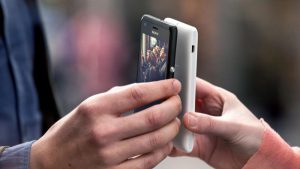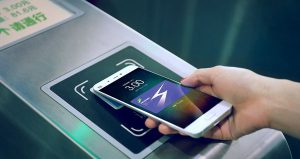 The history of NFC technology dates back to 1983. Then technologist Charles Walton received a patent for a device whose operation description is comparable to a modern NFC module. The first phone with built-in NFC appeared in 2006. But technology has become truly widespread only in the past few years.
The history of NFC technology dates back to 1983. Then technologist Charles Walton received a patent for a device whose operation description is comparable to a modern NFC module. The first phone with built-in NFC appeared in 2006. But technology has become truly widespread only in the past few years.
NFC in a smartphone: technology description
The acronym “NFC” stands for Near Field Communication (in other words, Near Field Communication). In fact, this is another technology for wireless data transmission and reception. Moreover, it is radically different from classic wireless interfaces such as WiFi and Bluetooth, both in specifications and in areas of application.
NFC has a relatively low data transfer rate (up to 424 kbps), so it is not suitable for transferring large files. In addition, this technology cannot boast of a long range – it is only 10 cm. However, such 'disadvantages' are not really such. Rather, it is a necessity due to the specifics of the technology application.
The purpose of the NFC interface is to ensure the creation of an operational connection between two devices and the secure exchange of information. The short range eliminates the possibility of intercepting the transmitted data. And the low bandwidth is compensated by the connection speed, which is carried out in a split second. For example, using Bluetooth the connection between devices takes much longer. In addition, the active NFC interface uses a lot less power than WiFi.
to the content
The role of NFC in everyday life
Contactless communication technology is used in many fields to facilitate certain actions. But if we are talking about a smartphone, then the use cases are currently limited to several options.
Contactless payment. NFC-enabled smartphones can be used to pay for goods. It works like this. The bank card data is saved in a special application, and when the customer touches the phone to the terminal, the payment information is transferred via NFC. This eliminates the need to carry around a pack of bank and bonus / discount cards.

Data exchange. In OS Android, starting from version 4.0, there was a function Android Beam (or S Beam in Samsung smartphones), which allows you to exchange files and other information. These can be links, contacts, geolocation data, photos, etc. The exchange process is carried out using Bluetooth or Wi-Fi Direct, but the NFC module is used to speed up the identification and connection of devices.

Reading labels. NFC tags (or tags) can be found on advertisements, on product labels in Western stores, etc. The tag contains additional information about something, such as a link to a movie trailer or an expiration date. Tags can not only be read, but also created independently. For example, you can record an NFC tag with contact information and embed it in a business card. You can create a label with information about the WiFi network and stick it somewhere. Thus, guests of a cafe or hotel guests will be able to find out the password from WiFi by reading the corresponding tag through a phone with NFC.

Electronic pass. In the future, phones with NFC will be used as an electronic key. For example, for a pass to an office or company. Many places already have an electronic badge system, but smartphones are not used everywhere. The problem lies in the lack of uniform standards, which leads to incompatibility of equipment, frequencies and software. But it's only a matter of time.

to the content
How to find out if there is an NFC module in the phone
Previously, NFC chips were installed mainly in expensive, flagship devices. Later, with the spread of technology, near-field modules began to be introduced into the mid-budget segment. Nowadays, even some inexpensive smartphones are equipped with such chips. And, judging by the trend, there is a possibility that in the future all mobile devices will be equipped with an NFC module.

In order for the signal to be stable, the NFC chip is installed under the back of the phone. But since not all smartphones are collapsible, it is easiest to check the support of the corresponding module using the software method. To do this, just select the 'Wireless networks' or 'Sharing and connections' item in the settings Android – of the device. The presence of the 'NFC' item will be a confirmation of the phone's support for this technology.

to the content
How to use NFC
To make contactless payments, you need to install special software. This could be Android Pay from Google, Apple Pay, or a banking app. Next, you need to turn on NFC, go to the installed program and attach your credit card to the payment service. After completing the setup, you can go to the nearest supermarket and pay for your purchases using your smartphone.

No additional software is required to transfer files and other data. It is enough to open the necessary information and attach the phones with their backs. A prerequisite is that the screen must be unlocked on both phones, NFC and Android Beam (or S Beam in Samsung smartphones) must be enabled. The screen data will be automatically sent after user confirmation.

As a rule, you do not need additional software to read NFC tags. It is enough to bring the smartphone to the tag, and the information hidden in it will be displayed on the screen. However, if you wish, you can use special software to obtain more detailed data, as well as to create your own tags. Alternatively, you can use the NFC Tools application to read and write tags.
